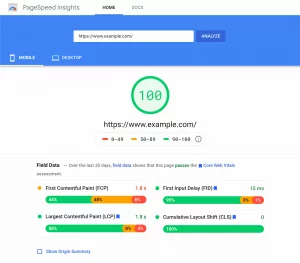Communities have long formed around brands, comprising dedicated customers eager to deepen their involvement, exchange knowledge, and spread the word. However, it’s only in recent times that brands have actively embraced this phenomenon through community marketing initiatives.
But what spurred this shift?
Community-based marketing is more than just a trend; it’s a philosophy that revolves around nurturing relationships, fostering trust, and building genuine connections with your audience. In this blog post, let us explain to you the essence of community-based marketing, its benefits, and how businesses can implement it to thrive in today’s competitive landscape.
What is Community-Based Marketing?
In 2024, we find ourselves amidst a period of transition in both marketing and society at large. (Isn’t change a constant?) Amidst these shifts, three prominent trends are steering both consumers and brands toward embracing community:
- Erosion of Traditional Marketing Effectiveness: Traditional marketing tactics are losing their efficacy. Consumers are bombarded with a barrage of advertisements and information, both online and offline. Brands struggle to capture and maintain their audience’s attention amidst this overwhelming noise.
- The Evolution of the Internet: The emergence of the internet is reshaping the digital landscape, introducing a decentralized model for sharing information and ideas. Beyond the world of cryptocurrency tokens and NFTs, a paradigm shift appears towards fostering belonging and cultivating communities.
- Rising Levels of Loneliness: Society grapples with a concerning surge in mental health issues and social isolation. Shockingly, fifty-one percent of Americans aged 18-24 have sought medical treatment for mental health concerns. In this climate, people crave genuine connections and communities that offer more than mere consumption— they seek purpose and belonging.
The Benefits of Community-Based Marketing
1. Loyalty and Retention
One of the primary benefits of community-based marketing is the ability to increase customer retention. When individuals feel connected to a brand or its community, they are much more likely to stay loyal and continue supporting it over time.
The sense of belonging within a community plays a pivotal role in fostering this loyalty. People who are part of a brand’s community feel personally invested in the brand’s success, as they see themselves as an integral part of the brand’s journey. They don’t just buy products—they identify with the brand, which strengthens their emotional attachment. This emotional bond makes them less likely to churn and more inclined to continue purchasing from your brand.
Moreover, when a community is actively nurtured, members become brand advocates, recommending your products or services to their friends, family, and social networks. This sense of shared ownership encourages people to stick around, knowing that they’re part of something bigger than just a transactional relationship.
2. Word-of-Mouth Marketing
A well-built community can serve as a powerful engine for word-of-mouth marketing. The individuals within your community aren’t just passive consumers—they become vocal advocates, sharing their positive experiences with others. When community members are satisfied, they are likely to spread the word about your products or services to those within their social circles, expanding your reach organically.
Word-of-mouth marketing is one of the most effective and trusted forms of promotion because recommendations come from a place of genuine experience. People trust their friends and family over traditional advertisements, making this kind of marketing invaluable. By cultivating a strong and passionate community, you effectively create a self-sustaining marketing engine that promotes your brand to new audiences without additional costs.
3. Feedback and Insights
Engaging with your community offers a treasure trove of insights that can guide your product development, marketing strategies, and business decisions. By regularly interacting with your audience, you gain direct access to their needs, preferences, and pain points. This feedback can be used to fine-tune your offerings, ensuring that your products or services better align with your customers’ expectations.
For example, through community conversations, polls, or surveys, you can learn about emerging trends, new customer demands, or potential areas for improvement. Listening to your audience in real-time allows you to adapt more quickly, ensuring that your business stays ahead of the curve and delivers exactly what your community wants.
In essence, your community becomes a valuable research tool, allowing you to make informed decisions that are in line with customer expectations.
4. Brand Authenticity
In today’s market, authenticity is a critical factor in building consumer trust. With so many options available, customers are increasingly looking for brands that are transparent, genuine, and human.
A community-based marketing strategy allows you to show the human side of your brand—whether that’s through behind-the-scenes content, genuine interactions, or openly addressing customer concerns. By engaging with your community in an authentic way, you demonstrate that your brand cares about more than just profits; you care about building meaningful relationships.
This authenticity can significantly differentiate your brand from competitors, especially when consumers feel that your actions align with your values. Transparent communication and authentic interactions help build trust and credibility, making it easier for consumers to connect with your brand on a deeper level.
5. Collaboration and Co-Creation
Communities offer an invaluable opportunity for collaboration and co-creation. Instead of relying solely on internal teams to develop new products, services, or marketing campaigns, brands can leverage their communities to help shape their offerings. Involving your community in the creative process fosters a sense of ownership, as members feel their input is valued.
Through collaborative initiatives, you can co-create products, social media campaigns, or even brand messages that resonate more deeply with your audience. This collaboration not only increases the relevance of your offerings but also boosts engagement, as members are more likely to engage with and promote products they helped create.
Co-creation also allows brands to tap into unique perspectives and ideas that they may not have considered internally, making their offerings more innovative and customer-centric.
From Followers to Advocates: The Art of Community-Based Marketing
1. Understand Your Audience
Before building a community, it’s essential to know who your audience is. Take the time to identify their interests, challenges, and aspirations. By understanding what drives them, you can create a community that speaks directly to their needs, values, and desires, ensuring higher engagement and relevance.
2. Choose the Right Platform
Selecting the appropriate platform to host your community is crucial for fostering engagement. Whether it’s a private social media group, a forum, or a dedicated community platform, choose a space that aligns with your audience’s preferences and offers the tools needed for meaningful interaction. The right platform should make it easy for members to connect, share, and engage in conversations.
3. Foster Active Engagement
Building a community is just the beginning; keeping it engaged is where the real work happens. Actively participate in discussions, respond to comments, and encourage your members to share their thoughts. Provide value through insightful content, helpful resources, and exclusive incentives to keep the conversation flowing. The more involved you are, the more invested your community will feel.
4. Listen and Evolve
Listening to your community is key. Actively monitor their feedback and be responsive to their needs. Whether it’s improving products, adjusting your messaging, or refining your strategies, show that you are adaptable and committed to meeting their expectations. This creates a two-way relationship where members feel heard and valued.
5. Celebrate Your Community
Recognition is a powerful motivator. Celebrate the contributions of your community members, whether through shoutouts, exclusive rewards, or special perks. Acknowledging their involvement not only boosts morale but also strengthens the bond between your brand and its most dedicated advocates. When people feel appreciated, they’re more likely to continue supporting and contributing to your community.
Examples of Community-based Marketing: : Why It Should Be Your Focus
1. Lego Ideas
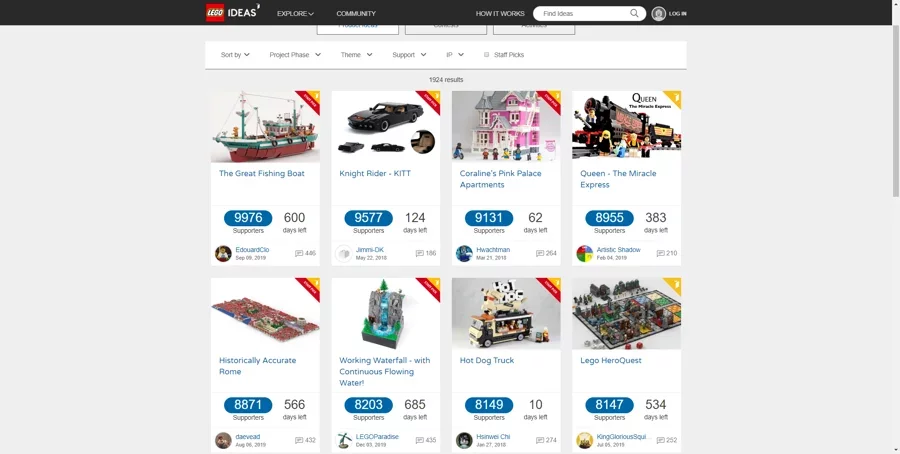
Lego’s community-based marketing is a prime example of how a brand can engage with its audience while fostering creativity and collaboration. Through Lego Ideas, a dedicated online platform launched in 2008, Lego allows its fans to share their own creative designs for new Lego sets. Community members can vote on, comment, and support their favorite ideas.
Lego not only nurtures the community but also moderates the platform lightly, giving members the freedom to express themselves while maintaining a space that’s aligned with the brand’s values. What’s truly remarkable is that Lego actively rewards this creativity. The best and most popular ideas are selected to be turned into actual products, and the creators receive recognition and compensation.
Since its launch, Lego Ideas has become a thriving ecosystem of creativity, empowering fans to influence product development directly. The program builds a strong sense of community and keeps the brand closely connected to the desires of its consumers.
2. Frugi Family
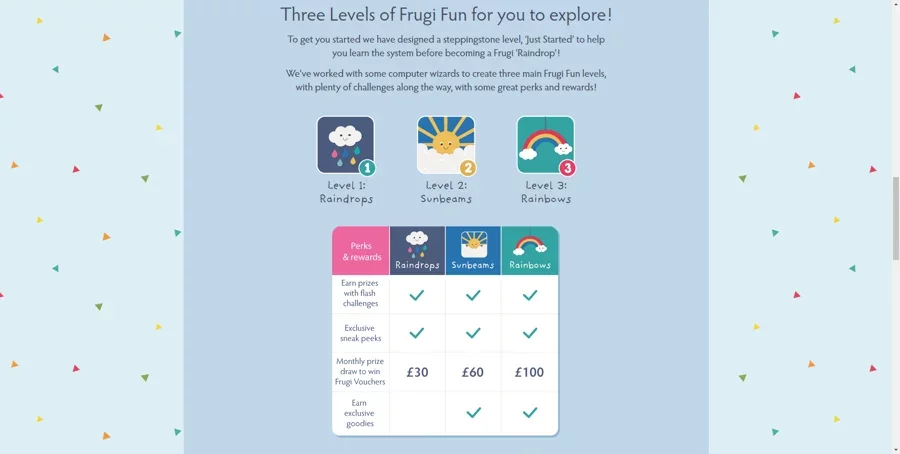
Frugi, a sustainable children’s clothing brand, has built a passionate community of parents through its Frugi Family initiative. The brand’s strategy combines multiple community touchpoints to engage with its core customers. One of the key platforms is their Facebook group, where parents share stories, photos, and moments related to their families. This informal setting fosters real conversations and a deeper connection with the brand.
Additionally, Frugi launched an advocacy program to formalize and reward engagement. Customers can earn rewards for completing activities such as sharing their experiences, referring friends, or participating in brand-related events. By providing structured incentives, Frugi has cultivated a community that is not only engaged but also actively advocating for the brand.
This multi-faceted approach—combining organic social media interaction with a more structured rewards program—helps Frugi build a loyal customer base. Each platform and program serves a unique purpose but ultimately strengthens the connection between the brand and its customers.
3. Lululemon
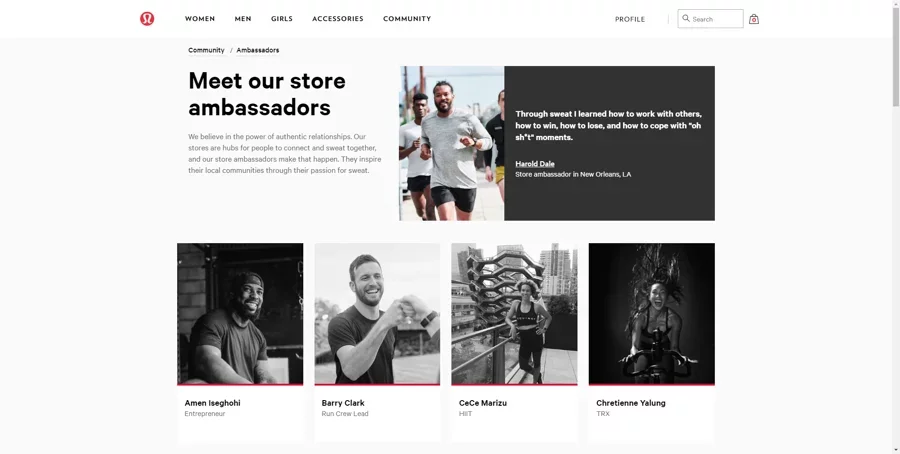
Lululemon has mastered the art of community-based marketing by focusing on localized, face-to-face connections rather than digital-only engagement. The brand’s strategy centers around building relationships with local influencers, such as yoga instructors, fitness trainers, and studio owners. Lululemon sponsors products for these local leaders and collaborates with them to host events, classes, and activities in their communities.
What sets Lululemon apart is their decentralized approach: local stores and ambassadors are empowered to cultivate these relationships, ensuring they are grounded in the unique culture of each neighborhood. This local focus strengthens bonds and ensures that Lululemon’s community-building efforts are authentic and relevant to the area. The result? Stronger, deeper relationships that foster customer loyalty in a way digital-only efforts can’t replicate.
Through this strategy, Lululemon has turned each store into a community hub, helping to drive brand loyalty and growth while staying true to its roots in wellness and fitness.
4. Adidas Creator’s Club
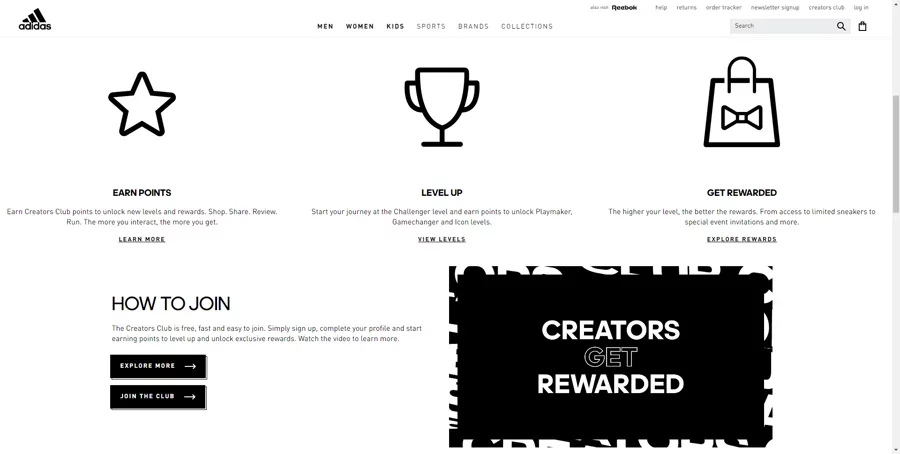
Adidas’ Creator’s Club is a perfect example of how to engage a community through a well-designed rewards program. This robust membership initiative encourages participants to complete activities—such as uploading workout photos, sharing fitness accomplishments, or participating in fitness challenges. In return, members earn exclusive rewards like early access to sales, product discounts, and invitations to special events.
What makes Adidas’ program unique is its level of brand involvement. Unlike Lego’s more organic community platform, Adidas directly structures the activities, rewards, and experiences available to its members. This requires a deep understanding of the target audience’s motivations and preferences, but when executed correctly, it creates a highly engaged and motivated community.
By giving customers tangible incentives and experiences, Adidas not only strengthens its brand affinity but also drives consistent interaction. Their focus on exclusivity and rewards makes participation feel special, further solidifying the emotional connection members have with the brand.
5. Starbucks
Starbucks stands out as a prominent example of successful community-based marketing. The renowned coffee chain has cultivated a dedicated following by offering a distinct and personalized experience to its customers. Central to its success is the company’s customer loyalty program, which has played a pivotal role in fostering loyalty and encouraging repeat patronage. As a result, Starbucks has witnessed an uptick in sales and an increase in customer referrals.
How is Community Marketing Measured?
One of the biggest challenges marketers face when implementing a community-based marketing strategy is measuring its success. Unlike traditional marketing, where success can be easily tracked with hard metrics, there are no standardized community marketing metrics universally accepted by the industry. Much of the value of community marketing is qualitative, measured through observation, feedback, and customer sentiment.
However, this doesn’t mean that community marketing cannot be measured. In fact, marketers can still apply traditional goal-setting frameworks to track community marketing effectiveness. A simple, yet effective approach is to break down the process into four steps:
- Objective
- Measurable Goal
- Tactic
- Cost
Example:
| Objective | Measurable Goal | Tactic | Cost |
|---|---|---|---|
| Increase sales of running shoes this summer | Generate $3.4M in sales from running shoes by the end of August 2020 | Gift 5,000 pairs of running shoes to running clubs | $500,000 |
The 10 Key Success Factors for Community-Based Marketing (CBM)
Building a thriving community around your brand isn’t just about gathering people—it’s about creating a space where relationships are nurtured, trust is built, and value is shared. Below are the 10 success factors that can help you unlock the full potential of Community-Based Marketing (CBM).
1. Define a Clear Purpose for Your Community
A successful community must have a clear and compelling purpose. Prospective members need to know exactly why they should join and what they stand to gain. Time is precious, and people will invest in communities that offer them tangible value.
It’s crucial to establish who your community is for, why it exists, and what members can expect. Make sure this is communicated clearly, and stick to your purpose. Think about your value proposition—what benefits will members gain from joining? What would they miss out on if they didn’t participate?
Create FOMO (Fear of Missing Out) to ignite excitement and encourage new members to join and engage.
2. Set Clear Objectives and Metrics
Establishing clear business objectives and measurable metrics is vital for tracking the success of your community. While growth and engagement metrics are common, they don’t always connect directly to business outcomes.
To align your community with broader goals, set objectives that contribute to measurable business impact, such as:
- Improved conversion rates
- Better product/service development
- Enhanced marketing effectiveness
- Reduced churn and higher retention
- Lower customer service costs
Measuring these outcomes will help you understand the true value of your community and guide ongoing improvements.
3. Small Can Be Powerful
Success doesn’t always require massive numbers. In B2B environments, quality often outweighs quantity. Communities that are too large can fragment and lose focus.
The concept of the Dunbar Number, which suggests that we can only maintain stable social relationships with around 150 people, is crucial to community management. In B2B communities, it’s often more effective to focus on quality engagement rather than sheer numbers. Smaller communities tend to foster deeper, more meaningful connections and more focused discussions.
4. Effective Community Management
A community manager (or similar role) is critical for a thriving community. Without a strong leader, a community can quickly lose direction and purpose.
The community manager’s role is not just operational—they must also possess empathy, resilience, and behavioral intelligence to nurture relationships, engage members, and ensure the community remains active and inclusive. A great community manager understands when to step in and when to let the community self-organize.
Invest in training and resources for this role to maximize its effectiveness.
5. Curate, Don’t Dictate
The best communities feel owned by their members, not just the brand. Strong communities thrive on peer-to-peer interaction, not one-way broadcasts from the brand.
Instead of dictating conversations or pushing content, create the right environment for your members to share their own ideas, experiences, and insights. Lead by example, encourage organic conversations, and allow members to take ownership of the discussions. This cultivates a sense of belonging and investment in the community.
6. Choose the Right Platform
While the right technology isn’t the sole factor for success, it plays a critical role. The platform you choose should facilitate engagement, support your community’s goals, and be flexible enough to grow with it.
Avoid platforms like Facebook Groups or LinkedIn, which are often poorly suited for long-term, data-driven community building. Instead, focus on platforms that offer greater control, better data insights, and more security. Tools like Guild or even good old-fashioned email lists can provide the flexibility and sustainability needed for B2B communities.
7. Build Trust
Trust is the foundation of any successful community. It takes time to build but can be easily lost. Ensure that your community is a safe and trusted space where members feel valued and respected.
This starts with clear community guidelines, consistent behavior from community managers, and a focus on authenticity and integrity in all interactions. Protect your community and foster trust by consistently acting with transparency and aligning your actions with your stated values.
8. Consistency, Persistency, and Rituals
One of the biggest surprises for new community managers is that consistency is more important than constant content posting. A regular cadence of interaction can be more powerful than sporadic bursts of content.
Create rituals or recurring events that your community looks forward to. Whether it’s weekly Q&As, monthly expert talks, or simple welcoming rituals for new members, these consistent touchpoints foster a sense of stability and belonging.
Building a community is a long-term process, and these rituals keep members engaged and invested in the community over time.
9. Embed Community into the Core of Your Brand
A successful community isn’t just a marketing project—it should be integrated into the DNA of your business. When community becomes a core element of your culture and strategy, it infuses all aspects of your brand, from product development to customer support.
Community should never be a peripheral initiative; it must be an essential part of the company’s mission. This ensures that leaders across the organization prioritize community engagement, helping to maintain alignment and consistency.
10. Recognize That Community Building is a Skill
Building and managing a community is a highly specialized skill. It’s not just about having the right technology or marketing strategy—it requires a unique combination of social, psychological, and communication skills.
Community managers need to know when to step back and let the community self-organize and when to step in to facilitate discussions or resolve conflicts. They also need to navigate the delicate balance of curating content and creating opportunities for members to engage.
Unfortunately, community management has historically been undervalued, but with the rise of CBM, more businesses are beginning to recognize its importance as a key marketing and relationship-building skill.
Maximizing Your Community’s Potential with the Right Hosting Solution
Incorporating community-based marketing strategies is an incredibly effective way to build trust, engagement, and long-lasting relationships with your audience. By focusing on building genuine connections, leveraging user-generated content, and actively participating in meaningful conversations, your brand can foster loyalty and grow a passionate community of advocates. Now, it’s time to elevate your brand’s online presence with a hosting solution that grows with you.
Start your journey today with a free trial of Nestify Hosting — experience the speed, reliability, and performance that can power your community-driven growth. Don’t wait—sign up for your free trial now and see the difference!
FAQs on the Future of Marketing
What role does technology play in facilitating community-based marketing efforts?
Technology platforms such as social media, online forums, community management tools, and customer relationship management (CRM) systems play a crucial role in facilitating community-based marketing efforts by providing channels for communication, engagement, and data analysis. However, technology should always complement and enhance human interactions rather than replace them.
What are the risks associated with community-based marketing, and how can brands mitigate them?
Risks include potential negative feedback or criticism from community members, the spread of misinformation, and the risk of brand reputation damage. Brands can mitigate these risks by establishing clear guidelines and moderation policies, being transparent and responsive in communication, and building trust through authenticity and accountability.
What are the key differences between community-based marketing and influencer marketing?
Community-based marketing emphasizes building relationships and fostering connections with a brand’s audience through meaningful interactions and shared experiences within a community. In contrast, influencer marketing involves partnering with individuals who have a significant following or influence to promote a brand’s products or services to their audience.



